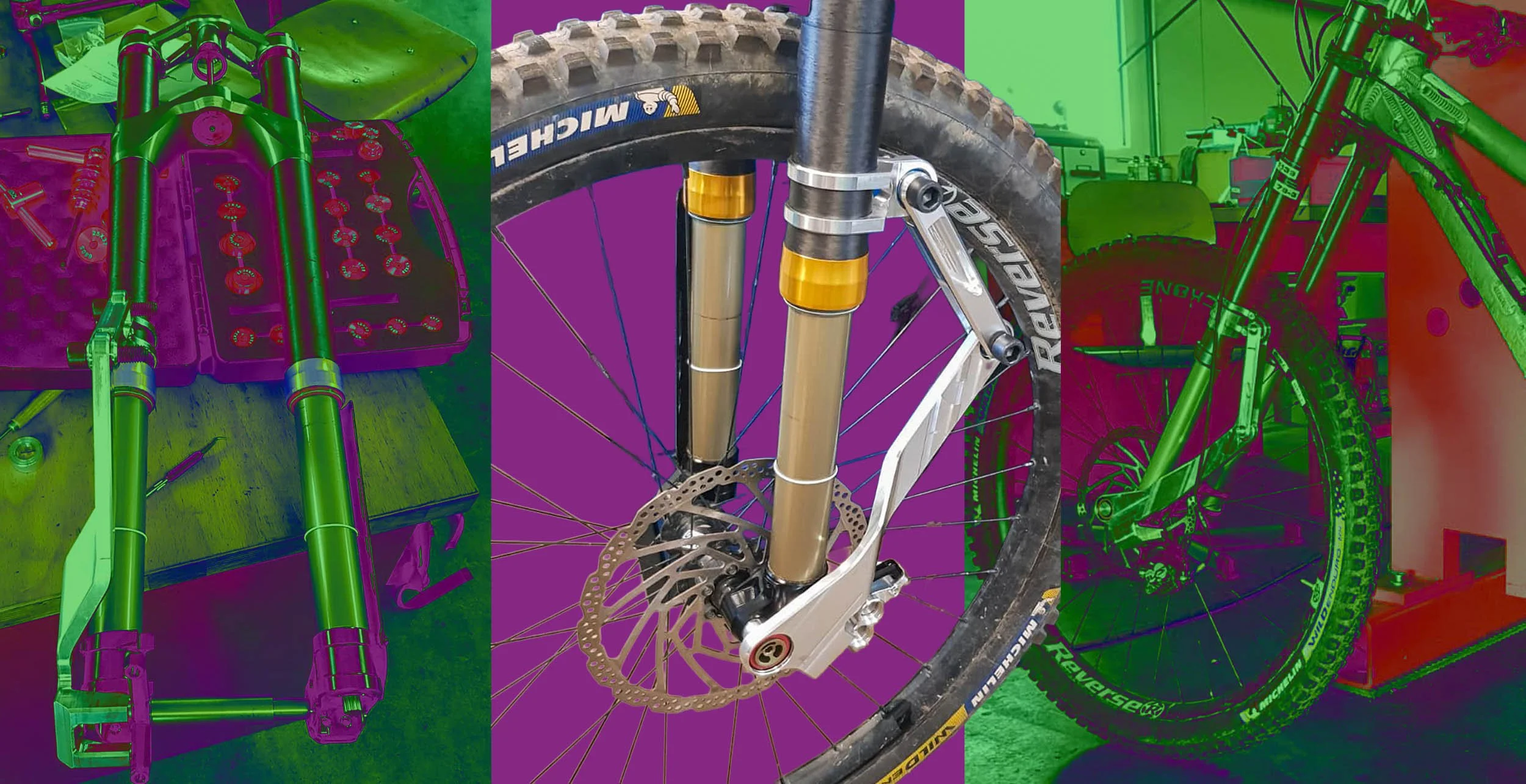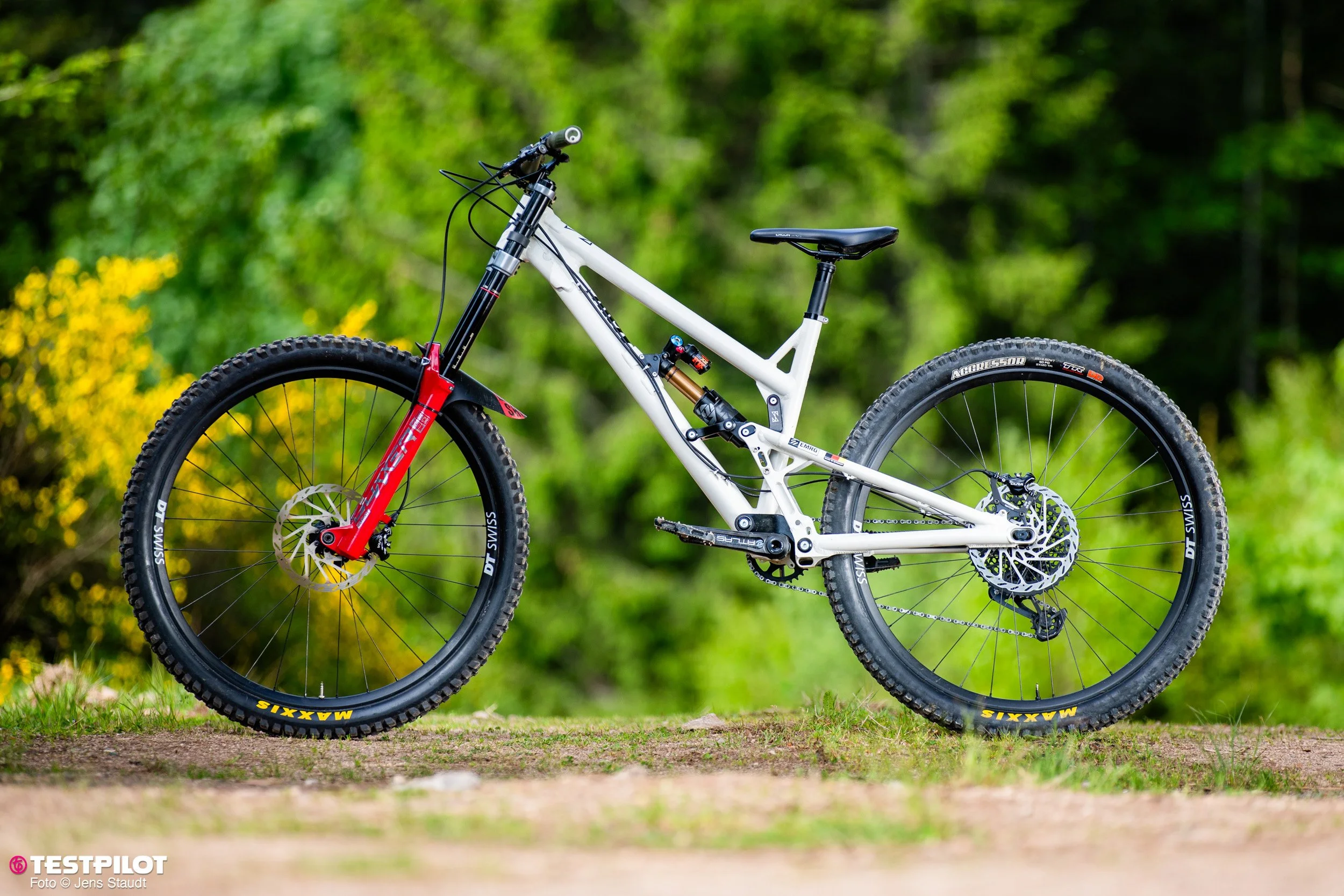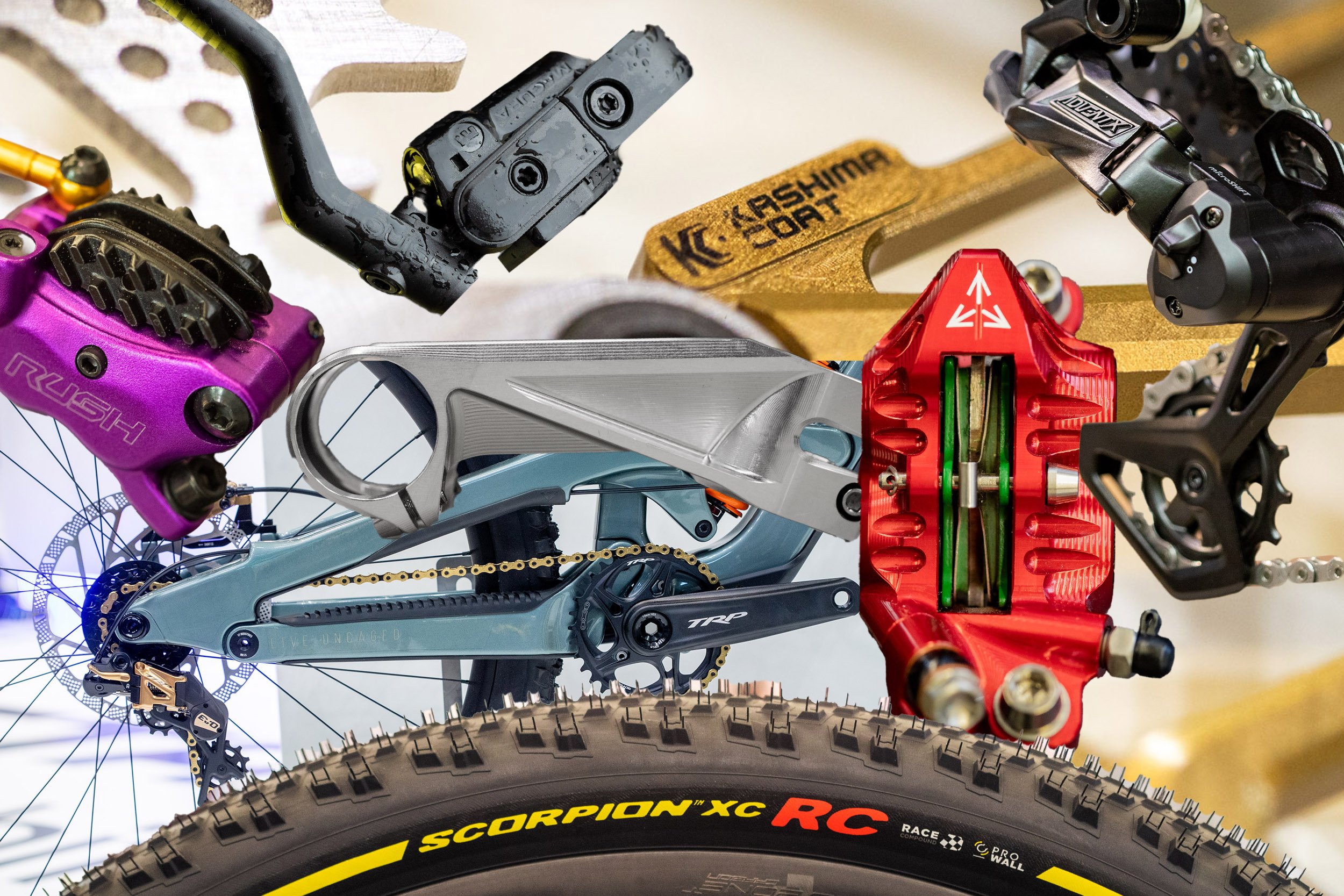Vorstellung: Stablead Carbon Fahrwerk, Brian Lopes und neue Komponenten
Lesezeit: 6 – 8 Minuten
Auf der Eurobike sorgte der neue Hersteller Stablead mit ihrer Upside-Down-Federgabel aus Carbon, einem Dämpfer mit Carbon-Body und einem gemufften Carbon-Bike für Aufsehen. Außerdem präsentierten sie ihre neuen Vorbauten, Pedale, Kettenblätter, Kurbeln und Sattelklemmen. MTB-Legende und Brand Ambassador Brian Lopes spricht mit uns über das Portfolio der Brand. Auf der Eurobike verrät er uns, was hinter Stablead steckt und wann die ersten Produkte erhältlich sein sollen. Außerdem gibt er uns einen Einblick in seine Rolle als Markenbotschafter.
Mehr Eurobike-News findest du hier.
Wer ist Stablead?
Die neue Marke Stablead wurde dieses Jahr in Burbank, Los Angeles, California gegründet. Stablead gehört der Firma Tilta an. Das 2010 gegründete Unternehmen entwickelt und verkauft hochwertige Foto- und Filmausrüstung. Mit Sitz in Shenzhen wurde Tilta damals mit Blick auf eine globale Ausrichtung geboren. Schließlich fassten sie mit ihrem amerikanischen HQ – Tilta Inc. – in Nordamerika Fuß. Ihre Kamerakäfige und anderes Kamerazubehör haben sich unter anderem in der Hollywood-Szene etabliert. Ihre großen Film-Ausleger und -Kräne für Autos kommen ebenfalls in Hollywood zum Einsatz. In diesen Vorrichtungen kommen Federungssysteme zum Einsatz, die elektronisch stabilisiert werden, wenn man zum Beispiel mit hoher Geschwindigkeit über eine Straße fährt. Ein spezielles Entwicklungsteam hat sich zur Aufgabe gemacht, diese Techniken auf MTB-Fahrwerke zu übertragen. Und warum genau will Tilta in den MTB-Markt einsteigen? Ganz einfach: die Geschäftsführer sowie viele Mitarbeiter sind große Mountainbike-Fans.
Carbon upside-down federgabel & Dämpfer
In den Eurobike-Versionen der Federgabeln und der Dämpfer waren noch keine voll funktionsfähigen Dämpfungseinheiten verbaut. Bei Gabel, Dämpfer sowie dem Carbonahmen mit 3D gedruckten Muffen und Riemenantrieb handelte es sich lediglich um Show-Exemplare, die nicht zum Fahren oder Proberollen geeignet waren. Hingegen zum Rahmen sollen Federgabel und Dämpfer aber auf jeden Fall in die Serie gehen – und das schon in Q1 2026. Brand Ambassador Brian Lopes fährt bereits Prototypen-Fahrwerke und steht im engen Austausch mit der Entwicklungsabteilung von Stablead.
Das Carbonbike mit 3D gedruckten Muffen und Riemenantrieb durften wir leider nur ablichten, nicht proberollen. Der Rahmen sowie das hier verbaute Fahrwerk dienen nur zum Showzweck und sind nicht fahrbar.
SFS-3601 Federgabel
Einteiliges Vollcarbon-Oberteil – Standrohre, Krone, Gabelschaft
Upside-Down Federgabel
Wahrscheinlich mit 150–160 mm Federweg
Compression-Verstellung (ohne Klicks und Auswirkung bei der Showgabel)
Rebound-Knopf fehlte bei der Showgabel
Lufteinheit mit max. 120 psi Gesamtdruck
15 mm Steckachse
Einsatzzweck: Enduro







SRS-3601 Luftdämpfer
Carbon-Luftkammer
Compression-Versteller
Rebound-Versteller
Lock-Out-Hebel
Einsatzzweck: Enduro




Komponenten
Alle Komponenten von Stablead bestehen aus einer exklusiven, besonders hochfesten 7075-Aluminiumlegierung, die in puncto Härte, Zugfestigkeit und Korrosionsbeständigkeit herkömmliche 7075-T6-Aluminium übertreffen soll. Die Oberfläche ist harteloxiert und zielt auf langjährige Farbstabilität und Abriebfestigkeit ab – auch unter intensiver UV-Belastung.
Jede Komponente wird per Röntgenprüfung auf Materialfehler untersucht, die Prüfdaten sind online rückverfolgbar – das soll ein Plus an Sicherheit und Transparenz sein.
Vorbauten
Stablead präsentierte vier verschiedene Vorbauten an ihrem Stand.
Einen leichten Vorbau mit nur zwei Klemmschrauben an der Unterseite des Lenkers.
Zwei Vorbauten mit einer 4-Schrauben-Klemmung – bei dem einen Vorbau ist der Klemmbereich breiter.
Und zu guter Letzt noch ein Direct-Mount-Vorbau für Doppelbrücken-Gabeln.
4‑Schrauben‑Vorbau
| Klemmdurchmesser (mm) | Länge (mm) | Höhe (mm) |
|---|---|---|
| 31,6 | 40 – 45 | 25 |
| 31,6 | 40 – 45 | 45 |
| 35 | 40 – 45 | 25 |
| 35 | 40 – 45 | 45 |
2‑Schrauben‑Vorbau
| Klemmdurchmesser (mm) | Länge (mm) | Höhe (mm) |
|---|---|---|
| 31,6 | 32 | 25 |
| 31,6 | 42 | 45 |
| 35 | 32 | 25 |
| 35 | 42 | 45 |
Pedalen
Ein Edelstahl-Achssystem aus 17-4PH mit PVD-Beschichtung zielt in Kombination mit Enduro-Bearings auf langlebige, reibungsarme Performance ab. Das Design-optimierte Pedalkörperprofil soll ein herausragendes Verhältnis von Stabilität zu Gewicht bieten. Die abgerundeten Kanten sollen „Schienbein-freundlicher“ sein.
SBP-01 Pedal
Diese Variante kommt sehr flach daher und hat dafür ein großes Enduro-Bearings-Lager an der Innenseite des Pedals.
Maße (Breite x Länge x Höhe): 110,7 mm x 115,5 mm x 8 mm
Durch das Lager an der Innenseite ist das Pedal dort 17,9 mm hoch.



SBP-02 Pedal
Das Pedal ist etwas schmaler, sieht mehr wie die meisten Pedalen aus und kommt in einer konkaveren Form.
Maße (Breite x Länge x Höhe): 118,5 mm x 99,8 mm x 15 mm



Kettenblätter
Kettenblätter gibt es in vier verschiedenen Designs und Größen sowie mit unterschiedlichen Aufnahmen für gängige Kurbeln.
Kettenblatt-Spezifikationen
| Aufnahme | Zähne | Offset (mm) |
|---|---|---|
| BCD 104 | 34 | |
| BCD 104 | 36 | |
| BCD 104 | 38 | |
| SRAM 3-Bolt | 30 | 3 |
| SRAM 3-Bolt | 32 | 3 |
| SRAM 3-Bolt | 34 | 3 |
| SRAM 3-Bolt | 36 | 3 |
| SRAM 3-Bolt | 38 | 3 |
| SRAM 8-Bolt DM | 30 | 3 |
| SRAM 8-Bolt DM | 32 | 3 |
| SRAM 8-Bolt DM | 34 | 3 |
| SRAM 8-Bolt DM | 36 | 3 |
| SRAM 8-Bolt DM | 38 | 3 |



Kurbeln
Die PH-14-Edelstahlschrauben mit PVD-Beschichtung sowie das Oberflächen-optimierte Design der Kurbelarme zielen auf ein exzellentes Verhältnis aus Stabilität und Gewicht ab. Die Kurbelarme sind in zwei Farbvarianten und in Längen von 150 bis 175 mm erhältlich.
Kurbelarm-Spezifikationen
| Spezifikation | Länge (mm) |
|---|---|
| EBIKE ISIS | 150 |
| 155 | |
| 160 | |
| 165 | |
| 170 |
| Spezifikation | Länge (mm) |
|---|---|
| SRAM 73DUB 3-Bolt / 8-Bolt DM | 155 |
| 160 | |
| 165 | |
| 170 | |
| 175 |




Sattelklemmen
Und auch die Sattelklemmen gibt es mit den PH-14-Edelstahlschrauben und den Merkmalen der anderen Komponenten. Verschiedene Farben waren zu sehen.
Interview mit Brian Lopes
Brian: We're here at Eurobike, and this is the new company that I'm involved with – it's called Stablead. We've got a wide variety of parts, everything from forks to stems, pedals, chainrings, cranks... the sky's the limit with this company. I'm super excited to be with them.
What's your position on it?
Brian: Well, my position is pretty wide here. I'm going to go with the title that you gave me, which is "Special Agent." I'm involved with everything from testing, R&D, helping them with the direction of the products, and how to make them better. I'm also introducing them to a lot of different people in the industry – marketing, athletes that hopefully we'll get involved with, and events that we'll get involved with in the future. Yeah, just kind of a wide variety of different things.
You have a very interesting product in front of you right here.
Brian: Yeah, this is an upside-down, fully carbon one-piece fork – the stanchions, the crown, the steerer – it's all one piece of carbon. Obviously, it's upside-down. It'll be about a 150 to 160mm fork. This is going to be, I think, a home run.
And you also have a shock on it?
Brian: Yes, we also have a shock here. Obviously, all these things are in prototype stages – they're not working yet – but we have a rear shock also with a carbon fiber can on there. Very cool-looking, I think, kind of unique and slightly different than other things you see out there.
Can you explain where this company is coming from? It appeared out of nowhere.
Brian: Stable is working under the umbrella of Tilta, and Tilta is a camera accessory company. They're very big in the Hollywood scene, making movies. They make a lot of camera cages and a lot of different accessories for cameras. They make big arm booms that hang off cars when they're filming for Hollywood. They have a very extensive, well-established brand in the Hollywood camera industry.
From my understanding, camera gear undergoes a lot of abuse, right? So is making bike parts the next step, as weird as it sounds?
Brian: Yeah, so in the camera industry, specifically with regards to the arms they make – these huge arms that hang off cars with very expensive, heavy cameras – those arms have suspension built into them. They're all electronically controlled for stabilization at high speeds on rough roads when they're doing filming. They already make some of these products, so transferring them over – adjusting, obviously, with some R&D – but a lot of the technology they already have.
Behind you, there's also a bike.
Brian: Yeah, so the bike that we have back here is something that we don't really plan on making. This bike was primarily built just to display the products that we have here at Eurobike. It's a one-off. It's pretty impressive – this bike is getting a lot of attention. And who knows? Maybe in the future, they'll decide to build a frame, but right now, there are no real plans to build a bike.
Can you show us some of the parts that will go to market pretty early? I mean, you have some stuff behind you.
Brian: Yeah, we have some cranks here – just some different finishes. The quality of the finish and the craftsmanship, as you can see, are very high-end. It seems like everybody is really impressed with the colors and how clean everything is.
We've got a bunch of different chainrings, different designs – just kind of aesthetic, whether you like this style or that style. The cranks – same thing – a few different colors, and obviously, they'll come in a few different lengths.
Stems – a few different styles: the triple-clamp direct mount, standard four-bolt... this one's pretty unique, super-wide clamping surface. And then probably the lightest-weight version with a two-bolt where you slide your handlebar through.
Maybe we can also see the flat pedals?
Brian: Yeah, two different styles of flat pedals here – one pretty low-profile, and then one that's a little bit more standard size with a little bit of concave to it.
When will this actually be available to buy?
Brian: That's still to be determined. We're not exactly sure. Obviously, there's a lot of testing and R&D that needs to go into it before we bring it to market. But we're hoping that by the beginning of the year, we should have some things to release.
So you're not riding this rig, but which bike are you using to actually test the products on?
Brian: Well, my bikes that I ride at home are the Ibis brand. I have a Ripmo, I have an HD6, I have an Exie, I have an Oso. So initially, I'll definitely be riding these forks and shocks – I'll be putting them all on my Ibis bikes. Those are the bikes I have the most time on, the ones I'm most comfortable on. So it'll be good when I go to test to have the products on bikes that I already know how they perform with other things on them.
Perfect. Thank you for giving us these insights, and looking forward to seeing this stuff on the trail!
Brian: Yeah, thank you! Thank you so much for taking the time to come visit Stablead, and hopefully, we'll have some product here pretty soon for you guys to give it a try.
Ihr wollt mehr Eurobike NEWS?
Autor – Yannick Noll
Größe: 178 cm
Gewicht: 75 kg
Fahrstil: Als ehemaliger Racer darf es gerne schnell und flüssig sein. Größere Sprünge und steile Rampen dürfen aber auch nicht fehlen. Das Bike ist etwas straffer und schneller abgestimmt, dass es entsprechend schnell auf Input vom Fahrer reagiert.
Motivation: Es soll Spaß machen. Ein Bike sollte nicht langweilig, alles platt bügeln. Der Charakter darf etwas lebendiger sein. Bei der Abstimmung, wie auch beim Fahrstil. Das Produkt sollte haltbar sein und auch auf längeren Biketrips sorgenfrei funktionieren.
















